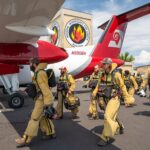
Smokejumpers are elite wildland firefighters who parachute into remote, rugged terrain to combat wildfires quickly—often serving as the first line of defense when time and access are critical . Here’s a deeper look at these courageous crews and their indispensable role:
🚨 The Mission: Swift, Aggressive Initial Attack
• Smokejumpers don heavy gear—approximately 85 pounds including parachutes, chainsaws, and survival supplies—and board fixed-wing aircraft like the C-212 Sherpa or Twin Otter .
• Once a fire is detected, crews parachute into remote locations, deploy their tools and equipment, and establish fire lines to halt the spread .
• They’re self-reliant for at least the first 48 hours, carrying food, water, and medical gear dropped alongside them .

🧠 Elite Training & Physical Demands
• Smokejumpers undergo intense physical preparation: timed runs, strength routines, and parachute drills on “the rack” before boarding the aircraft .
• To qualify, candidates must have prior wildland firefighting experience and pass rigorous endurance and skills assessments .
• And once deployed, their work is relentless: clearing forest ground and extinguishing hotspots with hand tools, often working overnight .
🌍 Widespread Reach & Rich Legacy
• Nine smokejumper bases across the U.S. (e.g., Missoula, Redmond, McCall, Boise, Redding) maintain readiness from spring through fall—and frequently deploy to Alaska and Canada .
• The practice began in the 1940s; pioneers like Earl Cooley parachuted into the Nez Perce National Forest in 1940 and founded the National Smokejumper Association .
• Today’s smokejumpers honor that legacy—operating in remote wilderness, often unseen, but essential to wildfire defense .

🌟 Why It Matters
• Speed saves lives: The ability to reach a blaze within hours often prevents small fires from escalating catastrophically .
• Adaptability: Smokejumpers frequently serve as mission leaders, initiating action swiftly and extending attack efforts .
• Conservation impact: Their early intervention protects ecosystems, resources, and communities in some of the hardest-to-reach areas.
🔥 In Action: A Day in the Life
When a siren sounds, teams of ten load gear and parachutes onto aircraft like the C-23 Sherpa or Twin Otter .
They jump into smoke-filled terrain, initiate a fire’s perimeter, and work continuously—often long past dark—until the fire is under control ().
Smokejumpers are a rare breed: part firefighter, part parachutist, all determination. They plunge into danger so that the rest of us can stay safe. Every jump, every fireline they build, safeguards lives and landscapes.






